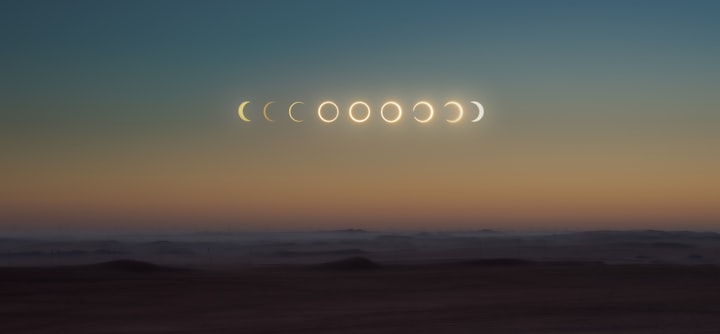Rare 'Ring of Fire' Solar Eclipse to Grace US Skies This Saturday
Partial Eclipse Precedes April's Total Solar Eclipse, Visible from Oregon to Texas

A solar eclipse, a breathtaking celestial spectacle, occurs when the moon gracefully glides between the Earth and the sun, creating a mesmerizing interplay of shadows and light. Over the forthcoming months, inhabitants and visitors of the Americas are in for a celestial treat, as they are poised to witness not one, but two extraordinarily rare events in the grand cosmic theater.
The inaugural act is a "ring of fire" solar eclipse, a magnificent phenomenon where the moon, positioned with celestial precision, appears to cradle the sun, creating an ethereal ring of radiant brilliance. In this cosmic ballet, the moon, slightly farther away than during a total solar eclipse, gracefully allows a golden halo of sunlight to encircle it, casting an enchanting aura in the sky.
This weekend will be graced by a partial ring of fire eclipse, heralding an even grander performance scheduled for April—an awe-inspiring total solar eclipse. The path of totality, a celestial passage veiling the sun in complete lunar embrace, will span a staggering 15 miles (185km) in width, stretching from the northern reaches of Mexico to the eastern expanse of Canada. This celestial journey will traverse thirteen U.S. states, weaving a tapestry of wonder from Texas to Maine.
San Antonio, the largest U.S. city in the eclipse's path, along with other communities along this celestial route, are eagerly preparing to extend a warm celestial welcome to the influx of visitors eager to witness this rare event. From the Alamo City to the quaint towns nestled in the eclipse's embrace, anticipation runs high for this cosmic rendezvous.
While parts of Puerto Rico, Hawaii, and Alaska will be treated to a partial eclipse, the elusive "ring of fire" effect will remain an ephemeral spectacle, reserved for those within the eclipse's heartland. The ethereal dance of shadows and light will paint a fleeting tableau, leaving an indelible mark on those fortunate enough to witness it.
As the lunar theatre continues its cosmic performance, next year promises another celestial marvel—a total solar eclipse on the 8th of April. This forthcoming event will be a celestial pilgrimage for stargazers, offering them an opportunity to witness the sun's complete retreat behind the moon, casting a spellbinding cloak of darkness over the land.
Beyond the sheer visual spectacle, a solar eclipse serves as a profound scientific canvas. It provides a fleeting but invaluable window into the intricate interplay between the sun and our home planet. Scientists seize this opportunity to unravel the mysteries of our celestial neighborhood, deepening our understanding of the radiant star that sustains life on Earth.
The celestial convergence has further effects, painting the world in surreal hues. Animals may respond to this momentary transformation, mistaking it for the onset of dusk. The temperature too, experiences a subtle dip, as if the Earth itself momentarily holds its breath in awe.
Solar eclipses have held a profound fascination for humanity since time immemorial. In ancient cultures, they were often interpreted as omens, signaling significant events or shifts in the cosmic order. Civilizations from the Mayans to the Greeks imbued these celestial events with a mystical aura, weaving them into their folklore and mythology.
The 20th century marked a turning point in our understanding of eclipses. The advent of modern astronomy and space exploration allowed scientists to unlock the secrets behind this captivating phenomenon. Today, we comprehend the precise celestial mechanics that choreograph this dance of the sun, moon, and Earth.
One of the most intriguing aspects of a solar eclipse is the elusive corona—a diaphanous aura of plasma that envelops the sun's silhouette. During totality, when the moon completely obscures the sun, this ethereal halo is revealed, casting an otherworldly glow. It's a sight that never fails to evoke a sense of wonder and reverence.
Moreover, eclipses offer a unique opportunity for astronomers to study the sun's outer atmosphere, which is typically too faint to observe against the brilliance of the sun itself. By carefully examining the corona and its fluctuations, scientists can gain insights into the sun's magnetic fields and their influence on space weather, providing valuable data for space agencies and satellite operators.
The human experience of a solar eclipse is a fusion of science, art, and emotion. Witnessing the transition from day to night in a matter of minutes, feeling the temperature drop, and hearing the hushed awe of onlookers—all contribute to the profound impact of this celestial event.
As we stand on the cusp of these upcoming eclipses, it's worth reflecting on the enduring wonder that they inspire. They serve as a reminder of the profound beauty and precision that govern the cosmos. In our fast-paced world, they invite us to pause, look skyward, and reconnect with the vast universe that surrounds us. So, as you prepare to witness these rare celestial ballets, let the experience be more than a visual marvel; let it be a moment of awe and contemplation—a reminder that we are all part of a grand cosmic tapestry.






Comments
There are no comments for this story
Be the first to respond and start the conversation.